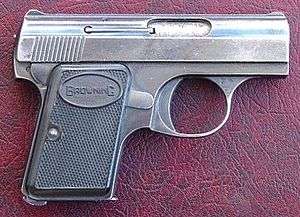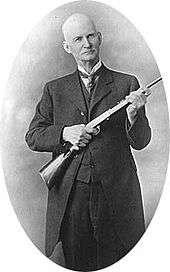FN Baby Browning
| FN Baby Browning | |
|---|---|
 | |
| Type | Pistol |
| Place of origin | Belgium |
| Service history | |
| Used by | French Resistance, US Air Force |
| Wars | World War II |
| Production history | |
| Designer |
John Browning Dieudonné Saive |
| Designed | 1927 |
| Manufacturer |
Fabrique Nationale de Herstal Manufacture d'armes de Bayonne Precision Small Parts, Inc. Precision Small Arms, Inc. |
| Produced | 1931–present |
| Specifications | |
| Weight | 275 g (9.7 oz) |
| Length | 104 mm (4.1 in) |
| Barrel length | 53.6 mm (2.11 in) |
| Height | 72 mm (2.8 in) |
|
| |
| Cartridge | .25 ACP 6.35mm |
| Action | Blowback-operated semi-automatic |
| Muzzle velocity | 230–500 m/s (750–1,640 ft/s) |
| Feed system | 6-round sealed bottom, flat follower magazine; a rounded follower and removable inner and outer bottom plates were incorporated in 1984 |
| Sights | Fixed iron notch and blade |
The FN Baby Browning is a small blowback-operated semi-automatic pistol designed by Dieudonné Saive based on a design by John Browning (among Browning's last designs) and chambered in .25 ACP (6.35×16mmSR). The pistol features a six-round magazine capacity and is a striker-fired, single action, blow back mechanism. The manual thumb operated safety locks the slide in the closed position when engaged using side thumb pressure.[1]
History
FN introduced the revolutionary model 1905 in 1905. Despite the name FN used for this pistol, it was later marketed as the "M1906", the "V.P. .25" (V.P. denoting Vest Pocket), and most confusingly, the "Baby" model. This pistol was introduced more or less at the same time the 6.35x16mm .25 ACP cartridge became widely available. The term "ACP" stands for "Automatic Colt Pistol". This cartridge was among the first automatic pistol cartridges to be utilized worldwide. It was designed with a "semi-rimmed" shell casing made of brass. The rim of the shell casing had a slightly larger circumference than the base of the cartridge and an extractor groove was cut directly above it. The shell casing head was spaced on this small rim; however, the utilization of the rim in this design complicated the mechanics of the cartridge because, while still in the magazine, the rim of one cartridge would sometimes get hung up on the extractor groove of the following cartridge (also known as "rim lock").[2]
The M1905/M1906 Vest Pocket pistol incorporated a grip safety mechanism that constituted the entire rear section of the grip. This particular safety mechanism required a significant amount of hand palm pressure to disengage and allow the trigger to release the striker to fire the pistol. Colt produced a nearly identical pocket pistol, the Colt Model 1908 Vest Pocket, which incorporated a small safety lever on the left side of the receiver which locked the trigger. In addition, this safety lever mechanism locked the slide about a half inch back from the front of the pistol to enable easy disassembly. FN also added this safety lever mechanism to its pistol, but did not add the magazine safety mechanism that Colt introduced in 1916.[3]
Design
Pressured by dozens of imitations and the proliferation of blatant unlicensed copies, FN began work in earnest on a successor product to the Model 1908 Vest Pocket pistol. The basic Vest Pocket pistol design was used as a starting point for the new design. Dieudonné Saive (who would later design the Browning Hi-Power pistol and FN FAL rifle) was asked during 1926-1927 to design the new pistol.[3] His design was smaller, lighter, and incorporated several refinements and improvements to the M1908 version. For example, the hand palm activated grip safety mechanism was eliminated and the small safety lever on the left side of the receiver was extended under the grip so that the thumb of a right-handed shooter could easily engage and disengage it using pressure applied to the side of the safety lever - rather than pushing it down into the receiver- without having to release one's grip on the pistol. This improvement was at the cost of the slide hold-back feature that was eliminated in the new design. The receiver has a full-length dust guard extending to the end of the slide and an area behind the trigger is relieved to allow a user to maintain a more substantial grip on the pistol. The Dieudonne Saive design also introduced a magazine safety mechanism similar to the one utilized on the Colt Vest Pocket pistol. Parts are not interchangeable between these pistols.[4] A cocking indicator was also incorporated on the back of the slide. This model was marketed under the name "Baby" - and some of the original thermal hardened plastic grips were molded with both the initials "FN" at the top of the grip in a circle and the word "BABY" at the bottom of the grip under a raised crescent. This particular pistol was and continues to be known worldwide as the "Baby Browning" pistol and is the pistol reflected in the picture accompanying this article, excepting the BROWNING marked grip which indicates a more recent (circa 1960 and beyond) production run utilizing nylon impregnated polymer grips.[2]
Manufacturing history
European-based production
FN manufactured and marketed the Baby Browning pistol from 1931 until 1979, though exports to the USA only took place between 1953-1968. About 500,000 units were produced, including the hand chiseled engraved "Renaissance" and the "Lightweight" version. The Lightweight utilized a 6061 T6 aluminum receiver and chrome-plated (over electro-less nickel) slide and external detail parts. This particular version of the Baby Browning pistol was developed and marketed in commemoration of the Concorde supersonic jet which was introduced to the public circa 1965. With the exception of special order nickel-plated units and the above-mentioned custom built pistols, all of the Baby Browning pistols were finished in hot blue. The halt to exports to the USA in 1968 was dictated by the Gun Control Act of 1968 which was precipitated by Robert Kennedy's assassination involving an Iver Johnson made revolver and signed into law by then President Lyndon Johnson. This federal legislation forbade the importation of certain firearms, among them the Baby Browning pistol. FN transferred production of the Baby Browning pistol to Manufacture d'armes de Bayonne ("MAB") during 1979. Based in France, MAB produced the pistol from 1979 until 1983 when bankruptcy forced it to shut down. Baby Browning pistol production ceased in Europe at that time and has not been revived.[2]
North American–based production – FN-sponsored
During 1982, discussions began between FN and its North American-based representative Jim Stone. These discussions were focused on securing a North American-based manufacturer for the Baby Browning pistol. In 1984, a Canadian Swiss screw machine shop with a world class reputation for producing aerospace and defense related components entered into a technology transfer and production agreement with FN. This company's name was Precision Small Parts, Ltd. It was based in Aurora, Ontario, Canada, and maintained a subsidiary in Charlottesville, Virginia. FN issued an order to PSP for 40,000 of the Baby Browning pistols. All of these pistols were to be exported to Austria under the Browning logo for re-distribution by FN to its non-USA customers. PSP's owner (Joseph Maygar Sr.) had a long working history with FN dating back to the days of the Hungarian Resistance Movement of WWII. PSP produced other firearms for FN, including sub-machine gun parts. In 1985, the Canadian authorities forced PSP to transfer production of the Baby Browning receiver to its Virginia facility, though PSP Ltd. continued to manufacture the slide and detail parts for the pistol, excepting the magazine which was contracted out to Mec-Gar of Italy. When the USA subsidiary of PSP applied for an export permit with the Department of State to transfer the pistols to FN via its Austrian contact, the export permit was denied. At that time, Austria was known to be a trans-shipment point for armaments for the Middle East and the presumption was and remains that State did not want a large number of Baby Browning pistols ending up in the Middle East at that time. The effect of this action on the part of State caused PSP to become insolvent (as it had amassed work in process of in excess of 40,000 Baby Browning part sets). The insolvency of the company precipitated a sale to a USA/Canadian-based investor group in 1991. During 1995 the production of the pistol was spun out by the investor group into a new entity which became known as Precision Small Arms (PSA).[5]
PSA currently produces several models, including presentations grade examples with gold engraving, alongside other fine materials. PSA is a "one-man operation", with 2 employees as of 2016. The PSA .25 is currently produced using CNC machining, with all parts hand-fitted to assure near perfection in fit and finish. PSA introduced a 303 stainless steel version of the pistol in 2008; in 2009 it re-introduced an all billet version of the Lightweight renamed the Featherweight which utilizes a 7075 drop forged aluminum alloy receiver. As of the beginning of 2010 all of PSA's 19 versions of the Baby Browning were being manufactured from billet.[5]
North American–based production – non-FN-sponsored
From 1972 until 1984, a company named Bauer Firearms of Fraser, Michigan from 1972–1984 manufactured and marketed an unlicensed copy of the Baby Browning pistol which was machined from 416 stainless steel.[6] The pistol was marketed as the Fraser-25 from 1984 to 1986.[7]
This pistol was an approximate copy of the Baby Browning and was designed as such in order to avoid copyright infringement claims from FN, which at that time still had US patent protection on various components of the Baby Browning pistol. For example, the Bauer copy was produced using 416 stainless steel investment castings while the FN Baby Browning slide and receiver were originally produced from 8620 steel billet, though in the 1950s were produced from 8620 steel investment castings.[8] The Bauer utilized a different auto safety spring and the barrel was removed (and the slide released from the receiver) by twisting it clockwise 45 degrees from top dead center, rather than counterclockwise, as is the case with the Baby Browning pistol. The Bauer has engraving on both sides of the slide, whereas the FN Baby Browning has engraving only on the side of the slide opposite the ejection port side.[7]
See also
References
- ↑ Shideler, Dan (26 June 2009). The Gun Digest Book of Modern Gun Values: The Shooter's Guide to Guns 1900-Present. Iola, Wisconsin: Gun Digest Books. p. 109. ISBN 0-89689-824-5.
- 1 2 3 Hogg, Ian; Walter, John (29 August 2004). Pistols of the World. David & Charles. pp. 29,115. ISBN 0-87349-460-1.
- 1 2 Precision Small Arms history
- ↑ FN-Browning historical site
- 1 2 Ramage, Ken; Sigler, Derrek (19 November 2008). Guns Illustrated 2009. Iola, Wisconsin: F+W Media, Inc. p. 29. ISBN 0-89689-673-0.
- ↑ Lee, Jerry (17 January 2012). Standard Catalog of Handguns. Iola, Wisconsin: Gun Digest Books. p. 53. ISBN 1-4402-3009-9.
- 1 2 Wood, J B (21 October 2007). Automatic Pistols Assembly/Disassembly. Iola, Wisconsin: Gun Digest Books. pp. 49–56. ISBN 1-4402-2630-X.
- ↑ Shideler, Dan (28 February 2011). Gun Digest Book of Semi-Auto Pistols. Iola, Wisconsin: Gun Digest Books. p. 91. ISBN 1-4402-2439-0.
